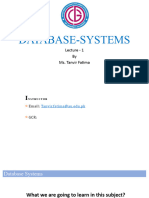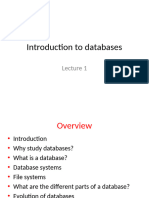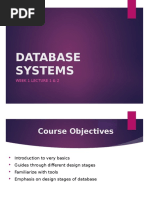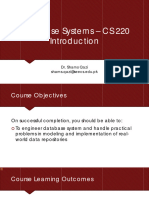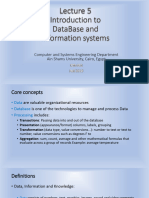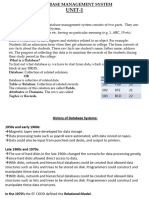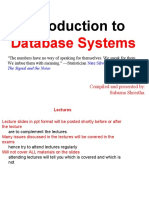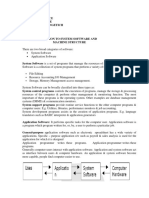L01-Introduction - What Is Database
Uploaded by
Viet DoanL01-Introduction - What Is Database
Uploaded by
Viet DoanINFO20003 Database Systems
Dr Renata Borovica-Gajic
Lecture 01
What are Database Systems?
INFO20003 Database Systems
Week 1 1
Data vs Information
• Data
– known facts stored and recorded
– can include: text, numbers, dates, plus images, sound, video,
and other complex objects
• Information
– Data presented in context (can be summarised data)
– Data that has been processed increasing the users knowledge
• Data vs Information
– Data is known and available; Information is processed and more
useful
Baker, Kenneth D. 324917628
Doyle, Joan E. 476193248
Finkle, Clive R. 548429344
Lewis, John C. 551742186
McFerran, Debra R. 409723145
Sisneros, Michael 392416582
INFO20003 Database Systems © University of Melbourne 2
Information: data in context
Database Systems Assignment 4 Marks
Semester 3 2014
Student Name Student ID Grade
Baker, Kenneth D. 324917628 H1
Doyle, Joan E. 476193248 H2B
Finkle, Clive R. 548429344 H3
Lewis, John C. 551742186 H2A
McFerran, Debra R. 409723145 P
Sisneros, Michael 392416582 H3
INFO20003 Database Systems © University of Melbourne 3
Information: Summarisation!
INFO20003 Database Systems © University of Melbourne 4
Metadata - Data about data
Name Type Length Description
Course Alphanum 30 Course ID
Tutorial Integer 2 Tutorial number
Name Alphanum 30 Student name
• Can include:
– structure, rules, constraints
• Why do we need Metadata?
– Consistency
– Meaning
• We generate a data dictionary as part of the analysis of
system requirements
INFO20003 Database Systems © University of Melbourne 5
What is a “database” ?
a large, integrated, structured collection of data
• Usually intended to model some real-world enterprise
• Example: a university
– Entities … such as courses, students, professors
– Relationships … such as enrollment, teaching
INFO20003 Database Systems © University of Melbourne 6
What Is a Database System?
A Database Management System (DBMS) is a software
system designed to store, manage, and facilitate
access to databases.
INFO20003 Database Systems © University of Melbourne 7
File Processing Systems
• What are the problems you can see with this?
• (Diagram adapted from Hoffer p. 42)
INFO20003 Database Systems © University of Melbourne 8
What’s Wrong Here?
• Program-data dependence
– If the file structure changes, so does the program
– What if you change data structure for one program
• Duplication of data
– wasteful, inefficient, loss of data integrity
• Limited data sharing
– data tied to application, hard/slow to create adhoc reports
• Lengthy development times
– application has to do low level data management, figure out file
format each time
• Excessive program maintenance
– up to 80% of development time in traditional file based
organisations is for maintenance
INFO20003 Database Systems © University of Melbourne 9
Database Systems as Solution
• Manage data in a structured way
• Many models (hierarchical, network, etc), but relational
dominant since ~1980
• Relational Model
–Rows & Columns forming Relations
–Keys & Foreign Keys to link Relations
Enrolled
sid cid grade Students
sid name login age gpa
53666 Carnatic101 5
53666 Jones jones@cs 18 5.4
53666 Reggae203 5.5
53688 Smith smith@eecs 18 4.2
53650 Topology112 6
53666 History105 5 53650 Smith smith@math 19 4.8
INFO20003 Database Systems © University of Melbourne 10
Database Advantages
• Data independence
– separation of data and program, application logic
– central data repository, central management
• Minimal data redundancy
– redundancy can be controlled (normalization)
• Improved data consistency
– single store: no disagreements, update problems, less storage space
• Improved data sharing
– data is shared, a corporate resource, not a necessity for an application
– external users can be allowed access
– multiple views of data, arbitrary views of data
• Reduced program maintenance
– data structure can change without application data changing
• Novel ad hoc data access ‘without programming’
– SQL
INFO20003 Database Systems © University of Melbourne 11
What’s Examinable?
• Difference between Data and Information
• Being able to discuss the advantages of Databases vs File
Processing Systems
INFO20003 Database Systems © University of Melbourne 12
Next Lecture
• The database system lifecycle
– With a focus on the design stage
• Conceptual design
• Logical design
• Physical design
INFO20003 Database Systems © University of Melbourne 13
You might also like
- Introduction To Databases: Course Introduction A Review of Database ConceptsNo ratings yetIntroduction To Databases: Course Introduction A Review of Database Concepts43 pages
- CSE031.Lecture - 05.introduction To Database - Fall 2019No ratings yetCSE031.Lecture - 05.introduction To Database - Fall 201929 pages
- CP 224: Database Management Systems: InstructorsNo ratings yetCP 224: Database Management Systems: Instructors22 pages
- Lecture 1- Database Concepts and File Base ApproachNo ratings yetLecture 1- Database Concepts and File Base Approach41 pages
- BCA - 5 - S301T - Unit 1 - MR - PRADEEP - BHANDARINo ratings yetBCA - 5 - S301T - Unit 1 - MR - PRADEEP - BHANDARI37 pages
- Database Systems: Database Systems: Design, Implementation, and Management, Sixth Edition, Rob and CoronelNo ratings yetDatabase Systems: Database Systems: Design, Implementation, and Management, Sixth Edition, Rob and Coronel33 pages
- How To Find A Solution For Short Dumps From ST22No ratings yetHow To Find A Solution For Short Dumps From ST225 pages
- Software Project Management: Project Scope and ActivitiesNo ratings yetSoftware Project Management: Project Scope and Activities47 pages
- Overview On DMEE Tree With PMW Config StepsNo ratings yetOverview On DMEE Tree With PMW Config Steps33 pages
- sapnote-205528_Report painter_ILLEGAL_SIGN_FORMATNo ratings yetsapnote-205528_Report painter_ILLEGAL_SIGN_FORMAT2 pages
- Whats A Job in Linux: Option DescriptionNo ratings yetWhats A Job in Linux: Option Description3 pages
- Computer Science Notes On System SoftwareNo ratings yetComputer Science Notes On System Software52 pages
- 4.1 Applied Productivity Tools Using Word Processor: I. Learning Skills A. Learning CompetencyNo ratings yet4.1 Applied Productivity Tools Using Word Processor: I. Learning Skills A. Learning Competency4 pages
- Microsoft Office Sharepoint Server (Moss) For Developers: (Part 1)No ratings yetMicrosoft Office Sharepoint Server (Moss) For Developers: (Part 1)8 pages
- Introduction To Databases: Course Introduction A Review of Database ConceptsIntroduction To Databases: Course Introduction A Review of Database Concepts
- CSE031.Lecture - 05.introduction To Database - Fall 2019CSE031.Lecture - 05.introduction To Database - Fall 2019
- Lecture 1- Database Concepts and File Base ApproachLecture 1- Database Concepts and File Base Approach
- BCA - 5 - S301T - Unit 1 - MR - PRADEEP - BHANDARIBCA - 5 - S301T - Unit 1 - MR - PRADEEP - BHANDARI
- Database Systems: Database Systems: Design, Implementation, and Management, Sixth Edition, Rob and CoronelDatabase Systems: Database Systems: Design, Implementation, and Management, Sixth Edition, Rob and Coronel
- Software Project Management: Project Scope and ActivitiesSoftware Project Management: Project Scope and Activities
- 4.1 Applied Productivity Tools Using Word Processor: I. Learning Skills A. Learning Competency4.1 Applied Productivity Tools Using Word Processor: I. Learning Skills A. Learning Competency
- Microsoft Office Sharepoint Server (Moss) For Developers: (Part 1)Microsoft Office Sharepoint Server (Moss) For Developers: (Part 1)

